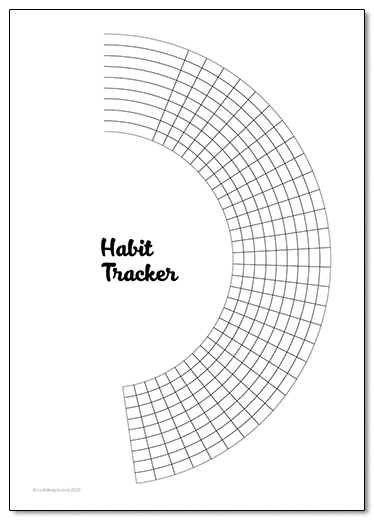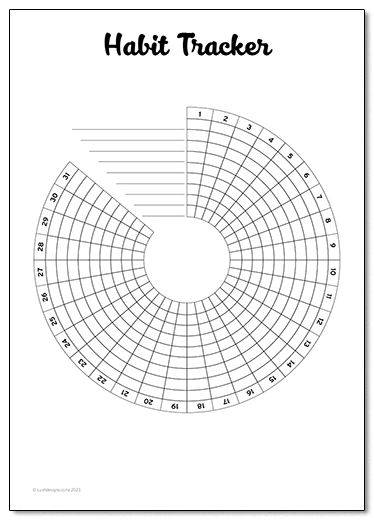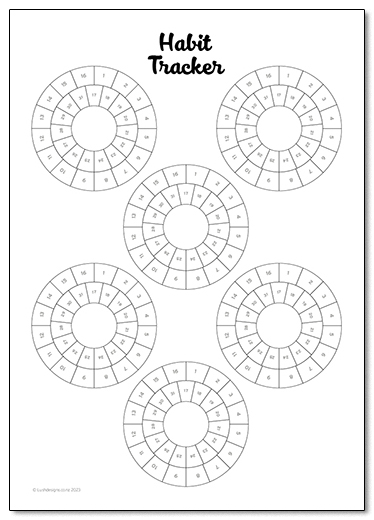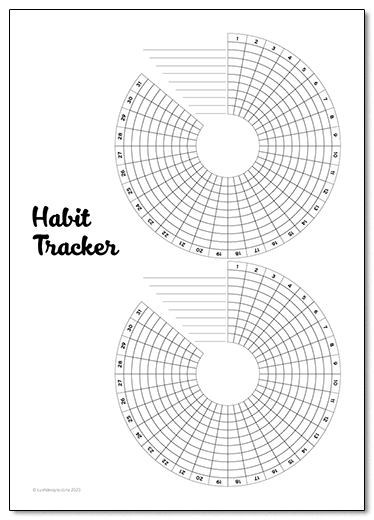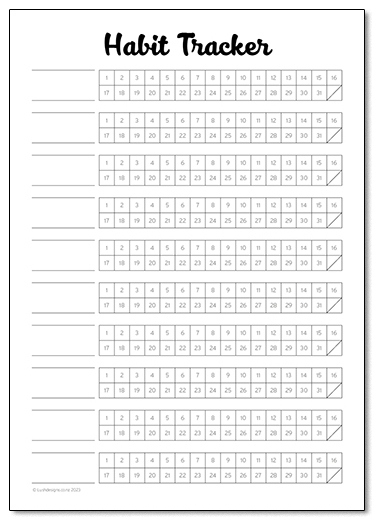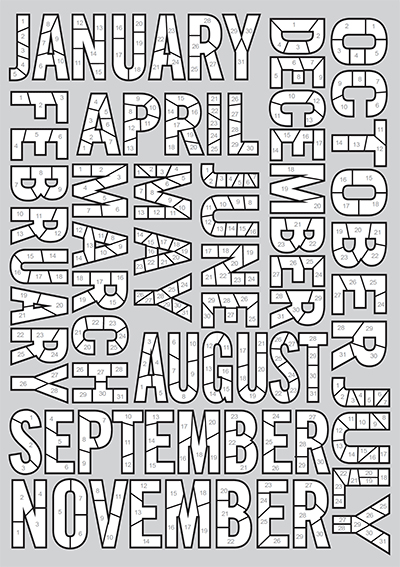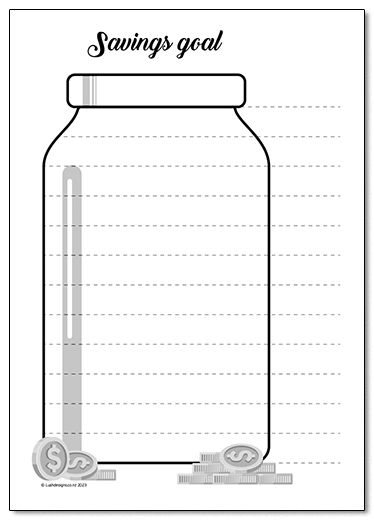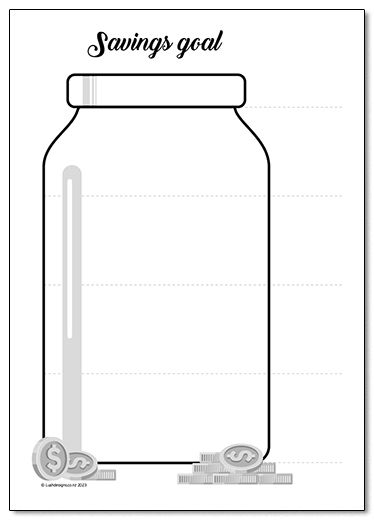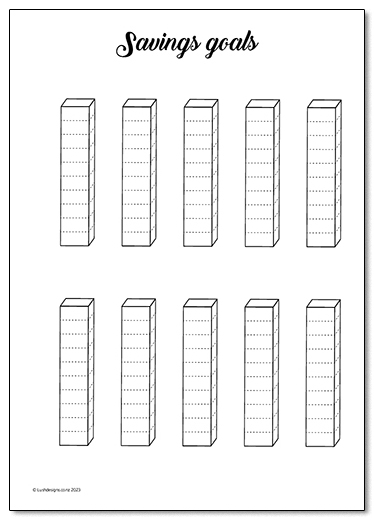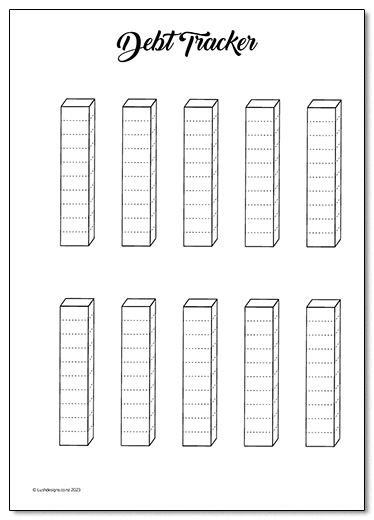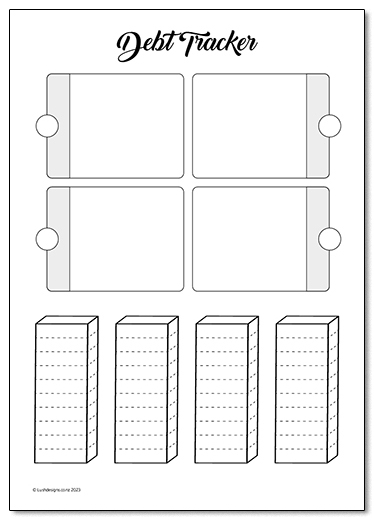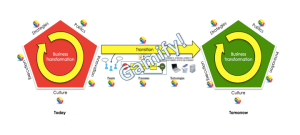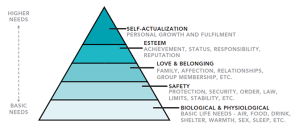Use these simple A4 printable Habit Trackers to help you build good habits and reach your goals.
Printable A4 Savings Goal Tracker
Do you want to increase your savings? Use these simple A4 printable Savings Goal Trackers to help record your progress.
Printable A4 Debt Tracker
Do you want to be debt free? Use these simple A4 printable Debt Trackers to help record your payments and progress.
Year Challenge Sheet
Here is what the Challenge Sheet Looks like

And here is the link to download Printable PDF — year – challenge sheet
Gamification: The Pursuit of Progression
A great article that pulls apart the term gamification, discusses gamification design, and then finishes by looking at a few interesting examples.
Game-ification: to transform into a game.
If creative commons internet linguistics resources are to be believed, the suffix -ification means ‘to become’, and is of Latin and French origin. You can see why the definition sparks so many debates. What exactly makes something “gamelike”? Are there different degrees of “gameness”?
What should and should not be gamified?
A quick internet search reveals that the vast majority of gamification is aimed at making “healthy” or “productive” tasks more entertaining. But don’t we usually use the word “productive” to describe something that consists of work, and “work” typically describes something that is only done because it needs to be done, for economic reasons or otherwise. The very nature of work itself then calls into question the applicability of games as a delivery medium, since the so-called lusory attitude generally states that players engage in games not out of necessity, but for the enjoyment of the experience.
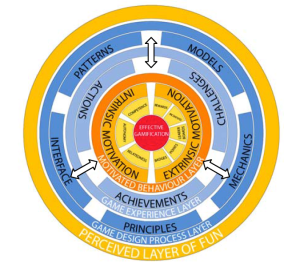
Habit RPG
HabitRPG, a gamified service. In essence, it is a fairly complex to-do list, spruced up with customization, themed collectibles, and social features. It’s fairly easy to get into, and seemingly addictive, with a simple, straightforward premise: set your own goals, and earn trinkets and prestige for completing them.
Zombies, Run!
Zombies, Run!, an app that abandons traditional point-based systems to motivate exercise by immersing users in an intermittent zombie apocalypse during their workout.
Chore Wars
Chore Wars, an old-style Dungeons and Dragons-esque game for knocking out housework. The integration of social family features promises to create some interesting household dynamics.
Duolingo
Duolingo, an app designed to assist in learning a new language through simple activities and reward mechanics. I found this one particularly interesting because it focused on acquiring new knowledge, rather than on work or exercise like many other apps.
Be sure to check out the original post by Samantha Stahlke to read the whole article
Stahlke, S. (2015). Gamification: The Pursuit of Progression. Retrieved 17 July, 2015 from https://medium.com/@hcigamesgroup/gamification-the-pursuit-of-progression-7da523d213c8
Kappen, D.L. Nacke, L.E. (2013). The Kaleidoscope of Effective Gamification: Deconstructing Gamification in Business Applications. Retrieved 17 July, 2015 from https://hcigames.com/download/the-kaleidoscope-of-effective-gamification-deconstructing-gamification-in-business-applications/
Anatomy of Fun
People play games because they are a source of fun. So what is fun? And how can I put it into my gamified learning app.
There are several well known theories on “fun”, any of the following types of fun can be combined with others to create a richer player experience.
NICOLE LAZZARO’S 4 KINDS OF FUN
In Nicole Lazzaro’s theory of fun she states that there are four different kinds of fun that are general categories that appear in any kind of game-like context (hard fun, easy fun, people fun and serious fun).(Werbach, 2013)
Each of the four types of fun unlock different types of player experiences.Nicole Lazzaro states that games that use emotions from four types of interactions are more likely to capture attention and motivate play.

MARC LEBLANC 8 KINDS OF FUN
While Marc LeBlanc believes there are 8 kinds of fun (sensation, fantasy, narrative, challenge, fellowship, discovery, expression, and submission).(ibid)
KEVIN WERBACH LISTS 14 ELEMENTS OF FUN
And professor Kevin Werbach lists 14 elements of fun (winning, problem solving, exploring, chilling, team work, recognition, triumphing, collecting, surprise, imagination, sharing, role playing, customisation and goofing off).These emotional components of the experience are what makes games engaging.(ibid)
PIERRE-ALEXANDRE GARNEAU’S 14 FORMS OF FUN
And Pierre-Alexandre Garneu lists 14 forms of fun (Beauty, Immersion, Intellectual Problem Solving, Competition, Social Interaction, Comedy, Thrill of Danger, Physical Activity, Love, Creation, Power, Discovery, Advancement and Completion, Application of an Ability).(Heeter, Chu, Maniar, Winn, Mishra, Egidio, & Portwood-stacer, 2004)
Jon Radoff 43 Fun Things
In Jon Radoff’s book “Game On” he lists 43 things that people find fun. He also created a table linking his list of fun things with Dr. Steven Reiss 16 basic human motivators.(Whatley, 2011)
Dr. Steven Reiss 16 basic human motivators
The 16 Basic Desires Theory is a theory of motivation proposed by Steven Reiss, Psychology and Psychiatry professor. After conducting studies involving more than 6,000 people, Reiss found that 16 basic desires guide nearly all meaningful behavior (Independence, curiosity, acceptance, order, saving, honor, idealism, social contact, family, status, vengeance, romance, eating, physical exercise, and tranquility).
“These desires are what drive our everyday actions and make us who we are,” Reiss said. “What makes individuals unique is the combination and ranking of these desires.”(Manrique, 2013)
The Problem with Fun
However there are some problems with focusing on “fun” as the only method of creating the players experience. As Dustin DiTommaso (2011) says “Fun is too diluted of a concept. It doesn’t distinguish the unique psychological experience of gameplay that leads to sustained engagement.”
DiTommasco, D. (2011). Beyond Gamification: Architecting Engagement Through Game Design Thinking. Retrieved 18 June, 2014 from Beyond Gamification: Architecting Engagement Through Game Design Thinking
Heeter, C., Chu, K., Maniar, A., Winn, B., Mishra, P., Egidio, R., & Portwood-stacer, L., (2004). Comparing 14 Plus 2 Forms of Fun in Commercial Versus Educational Space Exploration Digital Games. Michigan Stat University. Retrieved 5 April, 2014, from http://spacepioneers.msu.edu/forms_of_fun_july_2004.pdf
Lazzaro. N. (n.d.). The 4 Keys 2 Fun.http://www.nicolelazzaro.com/the4-keys-to-fun/
Manrique, V. (2013). Why people play games – Happiness, Motivation & Fun. http://www.gamasutra.com/blogs/VictorManrique/20130518/192533/Why_people_play_games__Happiness_Motivation__Fun.php
Whatley, S. (2011). 43 Things That Customers Think Are Fun. http://www.simonwhatley.co.uk/43-things-that-customers-think-are-fun
Werbach, K. (2013). 3.5 Anatomy of Fun (7:02 minutes). Retrieved from Coursera Gamification course.
5 Questions to Ask About Gamification
The term gamification refers to “the use of game design elements in non-game contexts.” (Deterding et al.) The non-game contexts imply that gamification is different than games and can be applied to society, business, technology and individuals at various levels.
Gartner goes a step further and defines gamification to be “the use of game mechanics and experience design to digitally engage and motivate people to achieve their goals.” Essentially what this means is that gamification is used to change the norms, attitudes and habits of individuals and organizations from a current state to a desired future state typically through the utilization of technology. Generally speaking, the use of gamification in the organization can be categorized into external uses (e.g., customer engagement) and internal uses (e.g., employee engagement).
In order for organizations to effectively leverage gamification as a game changer, they have to ask the following questions:
|
Currently |
In the Future |
| Who is using gamification externally and internally? | Who should be using gamification externally and internally? |
| What is gamified? | What should be gamified? |
| Where it is being used? | Where it should be used? |
| When are gamified types of activities are happening? | When should gamified types of activities be happening? |
| Why it is becoming a competitive advantage? | Why you should be using it as a competitive advantage? |
When you are asking the above questions across all levels of the organization, here are few things to keep in mind (1) have clearly defined goals for the players/users and the organization, (2) blindly applying gamification without thinking through organizational repercussions can be costly, (3) measure progress, get feedback and iterate, (4) create value since it is a not a one-way street but a multi-way street and (5) balance between intrinsic considerations and extrinsic rewards.
Here organizations have a choice about gamification as a (1) passing fad or (2) as a strategic lever that can help them transform. So, the real question about using gamification becomes,“Can you afford not to do it?”
Sebastian Deterding, Dan Dixon, Rilla Khaled, and Lennart Nacke. 2011. From game design elements to gamefulness: defining “gamification”. In Proceedings of the 15th International Academic MindTrek Conference: Envisioning Future Media Environments (MindTrek ’11). ACM, New York, NY, USA, 9-15. DOI=10.1145/2181037.2181040http://doi.acm.org/10.1145/2181037.2181040
“Gamification – Gartner IT Glossary.” Gartner IT Glossary. Gartner, n.d. Web.http://www.gartner.com/it-glossary/gamification-2/
Werbach, Kevin. “Coursera – Gamification.” Coursera. Coursera, n.d. Web.https://www.coursera.org/course/gamification
Krogue, Kevin. “5 Gamification Rules From The Grandfather Of Gamification.” Forbes. Forbes Magazine, n.d. Web. http://www.forbes.com/sites/kenkrogue/2012/09/18/5-gamification-rules-from-the-grandfather-of-gamification/
Stanley, Robert. “Top 25 Best Examples of Gamification in Business.” Clickipedia. Clickipedia, 24 Mar. 2014. Web. http://blogs.clicksoftware.com/clickipedia/top-25-best-examples-of-gamification-in-business/
Kleinberg, Adam. “Brands That Failed with Gamification.” – IMediaConnection.com. – IMediaConnection.com, 23 July 2012. Web. http://www.imediaconnection.com/content/32280.asp
What is Design Thinking and why is it better?
Before I give examples of use of Design Thinking for Business Innovation, it is important to give a quick overview of Design Thinking.
TRADITIONAL APPROACH
In traditional approach, for evaluating any business proposition, the two most important aspects that are taken into account by business executives are (1) Viability, and (2) Feasibility. This approach looks at the business benefits of a proposal (viability) and then evaluate whether it is doable in a practical manner (with through own resources or partnering with some) in a timely fashion or not (feasibility). The initiative which ranks the highest on these two metrics, is blessed with funding and kicked off. It seems like a very reasonable way of solving problems. Then why do more than 95 % of these initiatives do not live up to their expectations? There are several reasons:
- Both viability and feasibility projections are based on assumptions about the future.
- The approach follows
View original post 609 more words
Gamification
OVERVIEW:
People who have not heard the term “gamification” before perceive it to be about games but this is inaccurate. In order to address this misperception, Deterding and his team researched the various uses of gamification and came up with a definition that states gamification as “the use of game design elements in non-game contexts.” (Deterding et al.) We can see from this definition that gamification distinguishes itself from games by implying that while games are for fun without real world implication but gamification has implications in the real world. Broadly speaking, gamification continues to be applied to various areas of business, technology and society.
For this research paper, the focus is on the business and technology aspects of gamification. This leads to the definition by Gartner that states gamification as “the use ofgame mechanics and experience design to digitally engage and motivate people to achieve their goals.” In…
View original post 2,190 more words
The Revolution of Fun
The Revolution of Fun is a dissertation paper by Ferran Altarriba Bertran, conducted around the topic of gamification and serious games. Ferran looks at the potential of fun and games in non-entertainment contexts, the psychological theories and the basics of Game Design rules.
The Revolution of Fun
A study of applied games and fun as highly powerful tools to achieve goals in non-entertainment contexts through motivation and engagement.
The Theory of Fun
This section covers some of the usual things on Fun Theory like Maslow’s Hierarchy of Needs, and Johan Huizinga “Homo Ludens”…
Then moves on to defining what a game is:
- Elliot M. Avedon and Brian Sutton-Smith state that “games are an exercise of voluntary control systems, in which there is a contest between powers, confined by rules in order to produce a disequilibrial outcome.”
- Greg Costikyan, an American Game Designer and Science-fiction writter states that a game is “an interactive structure of endogenous meaning that requires players to struggle toward a goal.”
- Tracy Fullerton, Chris Swain and Steven Hoffman, who state that “a game is a closed, formal system, that engages players in structured conflict, and resolves in an unequal outcome.”
- Bernard Suits states that “To play a game is to attempt to achieve a specific state of affairs [prelusory goal], using only means permitted by rules [lusory means], where the rules prohibit use of more efficient in favour of less efficient means [constitutive rules], and where the rules are accepted just because they make possible such activity [lusory attitude].”
- Jesse Schell states “Games cannot simply be problem-solving activities. One who plays them must also have that special, hard-to-define attitude that we consider essential to the nature of play. So, a definition that nicely covers all ten qualities might be: ‘A game is a problem-solving activity, approached with a playful attitude.’”
- Raph Koster states “The definition of a good game is […] ‘one that teaches everything it has to offer.’ That’s what games are, in the end. Fun is just another word for learning.”
And briefly brings up Joseph Campbell’s narrative structure the Monomyth, also known as the “Hero’s Journey”.
Games and Psychology
This section looks at both the different forms of games (games, gamification, serious games, and gameful design), and the psychology behind games and fun.
Games, Gamification and Gameful Design
It starts with Andrezej Marczewki diagram where he divides games into four divisions, and also provides us with some definitions.
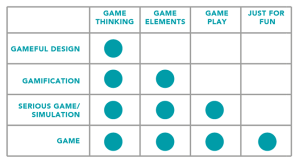
- Game: a Game is a problem-solving activity approached with a playful attitude (Jesse Schell, 2008, p.37).
- Serious Game: a Serious Game is a software or hardware developed through game technology and designed through game principles with a purpose different than just entertainment (Oscar Garcia-Panella, 2012).
- Gamification: Gamification is the use of game thinking and game mechanics in non-game contexts to engage users in solving problems. Gamification is used in applications and processes to improve user engagement, return on investment, data quality, timeliness, and learning.
- Gameful Design: a Gameful Design is the result of a design process where game thinking has been used.
Motivational Facts
This section looks at the motivational factors that games deliver (intrinsic and extrinsic), and touches on the RAMP model, which combines Daniel Pinks ‘purpose’ with Self Determination Theories ‘relatedness’, ‘autonomy’ and ‘Mastery’. After this it moves on to briefly mention Mark LeBlanc 8 Pleasures before discussing player types (Bartle, Marczewski, and Amy Jo Kim).
- Intrinsic motivation: it refers to enjoying something for the only fact of the pleasure among from its nature (for example, playing football).
- Extrinsic motivation: it refers to enjoying something due to the fact of there being a reward not necessarily connected to it (for example, working hard to get a salary). These rewards don’t necessarily have to be tangible (for example, a salary), they can be imaginary or virtual as well (a points system in a game).

- Relatedness: the desire to be connected to others.
- Autonomy: the desire to decide and choose own paths.
- Mastery: the desire of developing a skill, mastering it.
- Purpose: the desire to connect own actions with a greater reason. Often related to philantropism.
Game Design
This section explores the core parts of game design… game dynamics, mechanics and elements. It provides definitions for each and why they are important.
Starting with Dynamics where it briefly mentions Steven Reiss 16 Basic Desires and how they motivate human behaviours, before moving onto mechanics and Jon Radoff’s 42 kinds of activities that people enjoy doing, and ending with game elements (points, badges, and leaderboards).
At the end of this section it also briefly touches on Platforms and what to consider when deciding on the most appropriate one (e.g. analogue, digital, transmedia)—and storytelling as a key element in the system (motivating and engaging).
Conclusion
“games and fun in general represent something more than simply a way of entertainment. As they are directly related to human psychological needs and behavioural patterns, they become highly powerful tools for achieving goal”.
“If this relationship between human psychological patterns and game elements, mechanics and dynamics is clearly established, it means that game techniques and thinking can be used to successfully promote human behaviours.”
Bertran, F. A. (2014). The Revolution of Fun. Retrieved from http://www.ferranaltarriba.com/docs/therevolutionoffun.pdf

